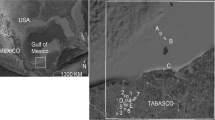Abstract
Comprehensive emission inventories for 2001 and 2004 for Kuwait’s main power stations located at Al-Doha and Al-Subyia have been prepared. These inventories are inserted, in conjunction with meteorological data, into the Source Complex model for Short Term Dispersion (ISCST4.5) to predict ambient ground level concentrations of sulphur dioxide (SO2) and nitrogen oxides (NOx) at selected receptors for years 2001 and 2004. The comparison of the results obtained for these 2 years show the influence of increase in emission rates due to urban and industrial growth. For model validation, computed results are compared with the measured daily average values of SO2 and NOx collected at a fixed Kuwait Environment Protection Agency air quality monitoring station located at the roof of polyclinic in Rabia. Individual contributions of each power station to the highest predicted values are assessed. The five highest hourly, daily and annual ground level concentration values under prevailing meteorological conditions are compared for 2001 and 2004. It is found that the hourly mean concentrations are strongly influenced by the prevailing meteorological conditions. The effect of meteorological conditions has not been that dominant for the daily and annual mean values and the predicted values for 2004 are higher than 2001, simply corresponding to a high emission rates, especially in summer months. Top 50 daily average values of SO2 show a slope of 0.806 for 2001 which means that the model predictions are 20% less than the observed levels. However, the predicted slope of SO2 for 2004 is 0.96 and the model predictions are in very close agreement with the observed data.







Similar content being viewed by others
References
Abdul-Wahab, S. A., Bouhamra, W., Ettouney, H., Sowerby, B., & Crittenden, B. B. (1999). Prediction of air pollution around heavily industrialized areas: use of the industrial source complex short-term model with emissions from a large number of sources. IChemE Environmental Protection Bulletin, 58, 3–13.
Al-Rashidi, M. S., Nassehi, V., & Wakeman, R. J. (2005). Investigation of the efficiency of existing air pollution monitoring sites in the state of Kuwait. Environmental Pollution, 138, 219–229. doi:10.1016/j.envpol.2005.04.006.
Al-Sudairawi, M., & Mackay, K. P. (1988). Evaluating the performance of the industrial source complex-(short term) model. Environmental Software, 3(4), 180–185. doi:10.1016/0266-9838(88)90032-9.
Al-Temeemi, A. S. (1995). Climatic design techniques for reducing cooling energy consumption in Kuwait houses. Energy and Building, 23, 41–48. doi:10.1016/0378-7788(95)00915-K.
Bouhamra, W. S., & Abdul-Wahab, S. A. (1999). Description of outdoor air quality in a typical residential area in Kuwait. Environmental Pollution, 90, 121–125. doi:10.1016/0269-7491(94)00086-S.
Briggs, G. A. (1973). Diffusion estimation for small emissions. Oak Ridge: Atmospheric Turbulence and Diffusion Laboratory, Contribution No. 79.
Manju, N., Balakrishnan, R., & Mani, N. (2002). Assimilative capacity and pollutant dispersion studies for the industrial zone of Manali. Atmospheric Environment, 36, 3461–3471. doi:10.1016/S1352-2310(02)00306-0.
Ministry of Electricity and Water (2002). Annual Statistical Review. Kuwait: Ministry of Electricity and Water.
Rama Krishna, T. V. B. P. S., Reddy, M. K., Reddy, R. C., & Singh, R. N. (2004). Assimilative capacity and dispersion of pollutants due to industrial sources in Visakhapatnam bowl area. Atmospheric Environment, 38(39), 6775–6787. doi:10.1016/j.atmosenv.2004.09.014.
Turner, D. B. (1970). Work book of Atmospheric Dispersion Estimates. Research Triangle Park: US EPA, AP 26 (NTIS PB 191–482).
US Environmental Protection Agency (1995). User’s Guide for the Industrial Source Complex (ISC4.5) Dispersion Models. User Instructions (vol. I). Research Triangle Park: US Environmental Protection Agency EPA-454/B-95-003a.
Author information
Authors and Affiliations
Corresponding author
Rights and permissions
About this article
Cite this article
Al-Azmi, B.N., Nassehi, V. & Khan, A.R. SO2 and NOx Emissions from Kuwait Power Stations in Years 2001 and 2004 and Evaluation of the Impact of These Emissions on Air Quality Using Industrial Sources Complex Short-Term (ISCST) Model. Water Air Soil Pollut 203, 169–178 (2009). https://doi.org/10.1007/s11270-009-0001-4
Received:
Accepted:
Published:
Issue Date:
DOI: https://doi.org/10.1007/s11270-009-0001-4




